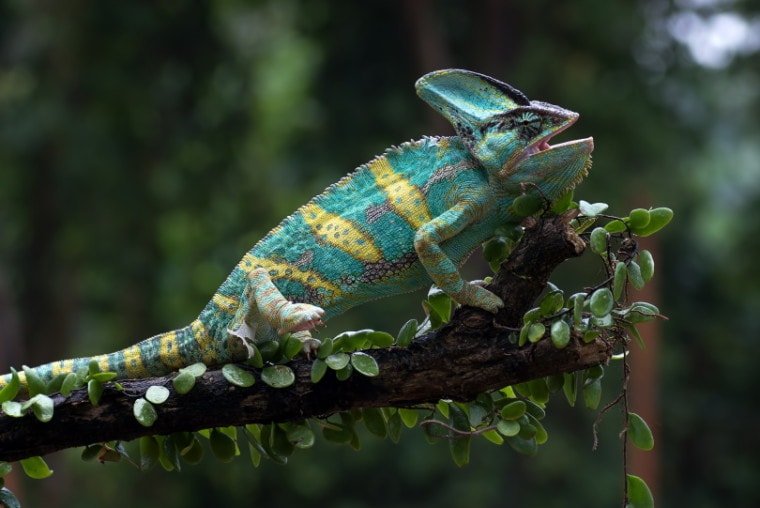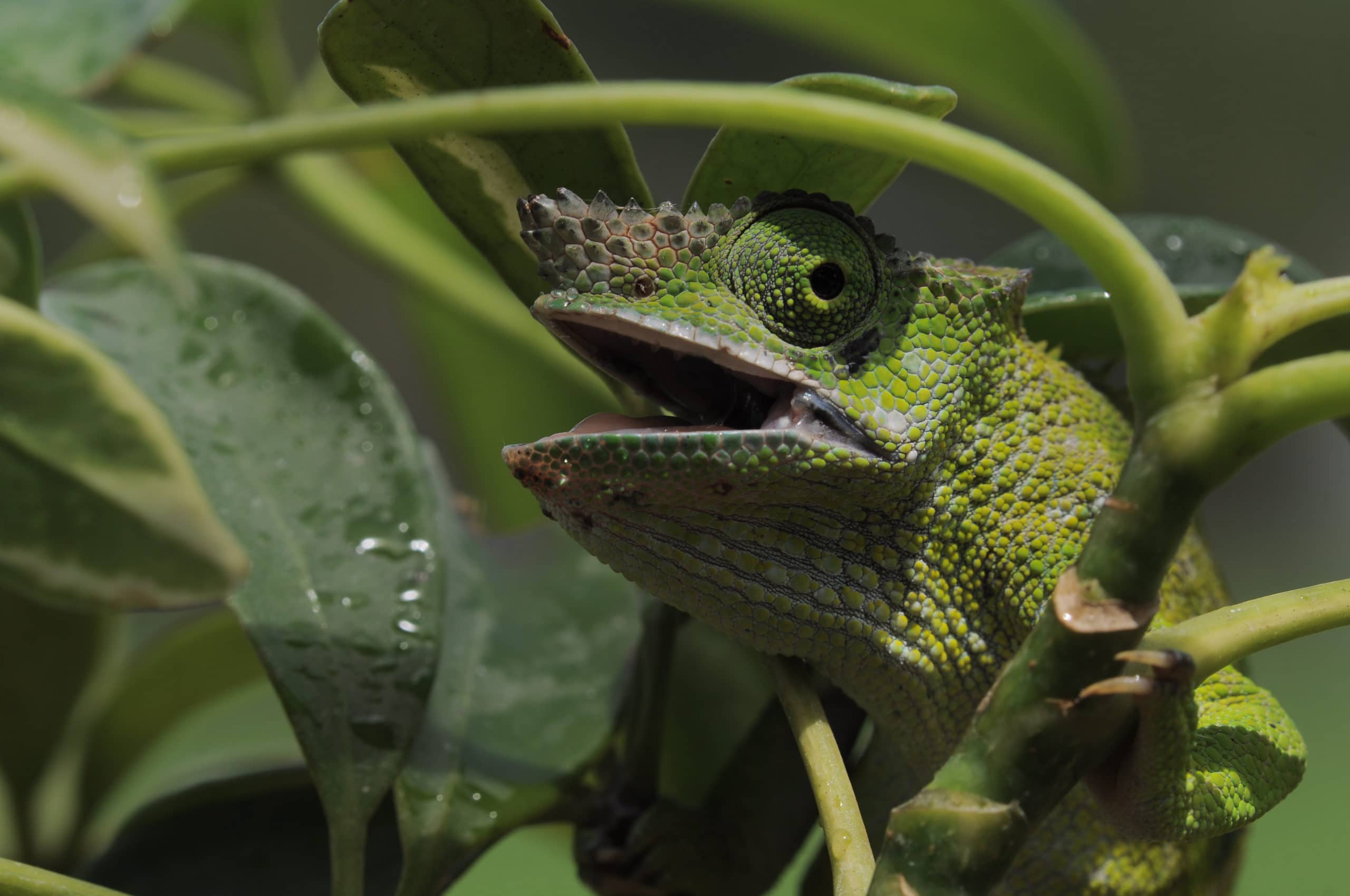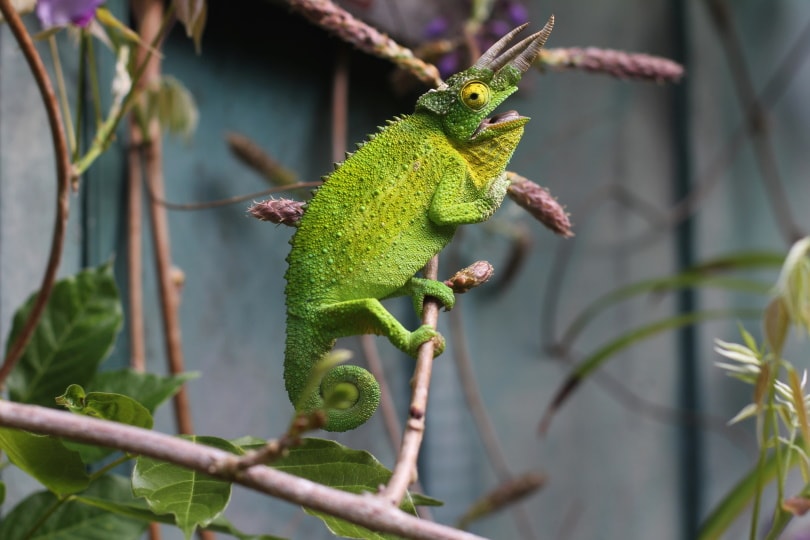
Chameleons have become increasingly popular pets for those that love taking care of more exotic creatures. If you’ve ever seen your reptile yawning, you may wonder what it signifies. Chameleons don’t yawn when they’re tired. Instead, they’re displaying a behavioral response that signals to an underlying cause.
There are several reasons why chameleons keep their mouths open. Keep reading to learn more about why chameleons could display this behavior and how to address them.
The 5 Reasons Your Chameleon is Gaping
When a chameleon is consistently keeping its mouth open for extended periods, it’s displaying a behavior called “gaping.”
Gaping doesn’t indicate a specific issue. Instead, it’s just a symptom of a deeper problem. These causes can be different depending on your chameleon. Five common causes can initiate gaping.
1. The Chameleon Feels Threatened
When a chameleon feels threatened and believes it has to act defensively, it will open its mouth. Opening the mouth makes the chameleon appear bigger so that its opponents feel more intimidated by its size.
Several factors can make a chameleon feel threatened:
If a chameleon feels the need to be defensive, it will display other behaviors. It will flatten its body, change into vibrant colors, and inflate its gular or throat area. It will also draw up its front hands into its body.
Keep in mind that chameleons will often prefer to be observational pets, so they like being left alone in quiet spaces. You can try to train them to get used to handling, but sometimes they just won’t like it when you pick them up.
Therefore, if you notice that they’re gaping whenever you come near their enclosure, it’s most likely that they’re trying to let you know that they don’t want you to touch them. Don’t take this personally. It doesn’t mean that your chameleon doesn’t like you. It’s just displaying a common behavior, and you can still bond with your chameleon without handling it.
If you think your chameleon feels threatened by noise or other pets, the best thing to do is move the chameleon’s enclosure to a quieter location and see if the gaping stops.
2. The Chameleon is Drinking Water
Chameleons rarely drink water from a bowl. In the wild, they find water droplets on leaves, especially after a rainfall. Chameleon owners should do their best to mimic these situations, or their chameleon is at risk of dehydration.
A dehydrated chameleon will gape and also have sunken eyes. The urate in its feces will not be the standard, healthy white color. Instead, it will be discolored and typically be yellow or brown.
The best way to keep a chameleon hydrated is to regularly mist the enclosure. Water drops should form and drip so that the movement catches the chameleon’s eye. A convenient way to mist an enclosure is to use an automatic misting system. This system ensures that your chameleon has plenty of opportunities to drink water, and you don’t have to worry about missing a misting.
3. The Chameleon is Shedding
Chameleons may gape when they’re about to shed. What they’re trying to do is stretch to loosen the old layer of skin from the new skin.
If your chameleon is shedding, you’ll also notice that its skin is opaque and dull. It may also wiggle and rub its body against sticks and other objects to help the skin shed.
Skin shedding can look alarming, but it’s a very normal process, so refrain from trying to help your chameleon shed. If you try to remove the old skin, it might damage and tear the new skin underneath. Just make sure that the misting system remains consistent. Environments that are too humid or too dry will make shedding more difficult.
A healthy shed lasts a couple of hours, so you’ll have a vibrant chameleon again soon enough.
4. The Chameleon is Overheated
A chameleon can also gape when it’s trying to cool down its body temperature. Along with gaping, it will display a paler shade to try to reflect the sun. It might also stay in lower and more shaded areas of the enclosure.
Act immediately if your chameleon is gaping due to overheating. This type of gaping is just a step away from your chameleon reaching a critical condition.
Make sure to move the enclosure to a cooler area of your home. You can also add an ice pack to the top of the cage to transfer some cool air inside.
Your chameleon will show that it has cooled off when it stops gaping and the color returns to its skin. When your chameleon is in a stable condition, take some time to re-evaluate its enclosure. Check to see if there’s a good temperature gradient where there are a lot of areas for shade and a designated basking area that’s at one corner of the enclosure.
You can also test out the heat lamp. If your hand cannot rest a couple of inches underneath it without experiencing discomfort, it’s too hot. In this case, opt for a light with less wattage.

5. The Chameleon Has Difficulty Breathing
The last common reason that a chameleon gapes is that it may have difficulty breathing. Sometimes, chameleons can develop respiratory infections due to bacteria.
If a chameleon has trouble breathing, it will usually stick its nose straight up to clear respiratory passageways. Then, it will gape. A chameleon that starts to close its eyes after gaping is in critical condition, and it needs to see a vet right away.
Since sticking the nose up in the air is almost a sure sign of difficulty breathing, contact your veterinarian at this stage instead of waiting until your chameleon starts gaping.

Final Thoughts
When your chameleon gapes, it’s communicating with you that a change is occurring or something is wrong. Be observant of any accompanying behaviors along with the surrounding environment.
Lastly, don’t hesitate to consult with your veterinarian. Chameleons are quiet creatures, so it’s better to receive professional input to identify the cause of your chameleon’s gaping.
Related Reads:
Featured Image Credit: DSlight_photography, Shutterstock







